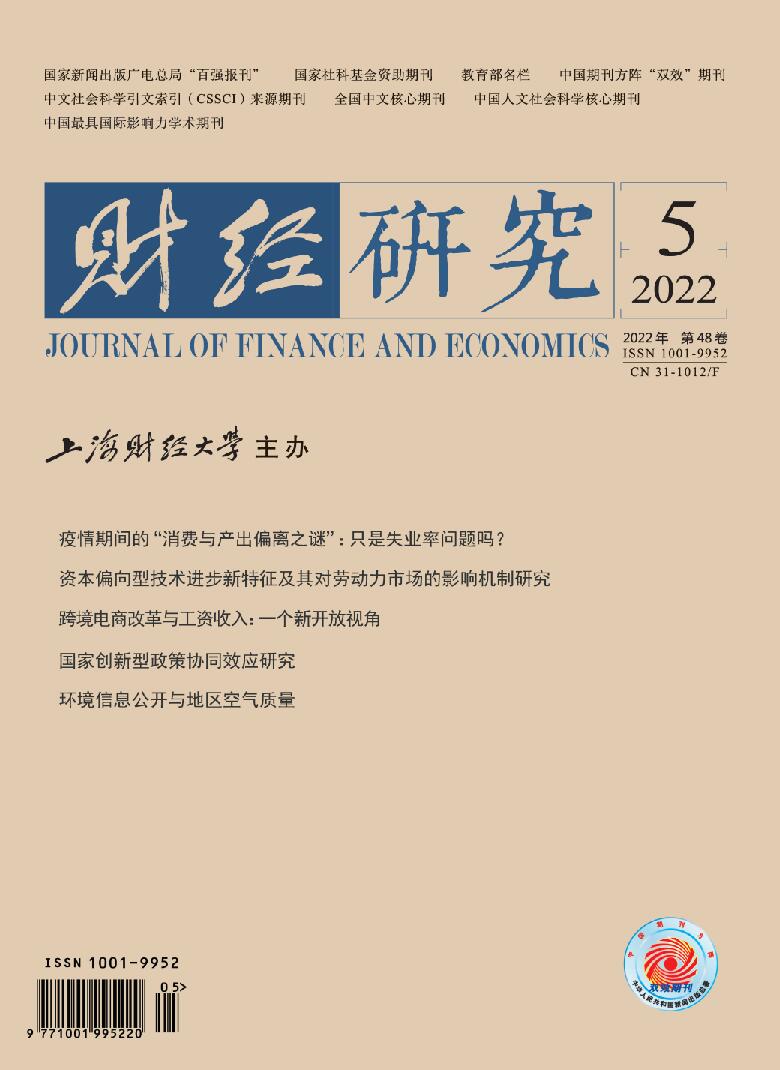在强调经济高质量发展的时代背景下,作为推动创新驱动发展战略实施的“排头兵”,国有企业被赋予了更多的责任与使命。文章基于双重差分模型考察了容错纠错机制对国有企业创新活动的影响及其背后的作用机理。计量结果显示,容错纠错机制的实施显著提升了国有企业的研发投入,经过一系列的稳健性测试后,该结论依然成立。机制检验证实,容错纠错机制通过提升风险承担和完善公司治理进而促进了国有企业的研发投入。异质性分析表明,股权激励和晋升激励有助于强化容错纠错机制对国有企业的创新激励效应,而货币薪酬激励则没有显著影响。进一步研究发现,容错纠错机制的实施不仅增加了国有企业的创新产出数量,而且还提升了其创新产出质量。这一方面表现为发明专利和实用新型专利显著增加,而外观设计专利没有明显变化;另一方面表现为创新产出的价值增值能力显著提升。上述结论表明,实施容错纠错机制,提高对创新失败的容忍度,同时辅以股权激励和晋升激励机制有助于提升国有企业的创新水平,进而助力经济高质量发展。
容错纠错机制何以激励国企创新?
摘要
参考文献
2 曹春方, 张超. 产权权利束分割与国企创新−基于中央企业分红权激励改革的证据[J]. 管理世界,2020,(9):155−168. DOI:10.3969/j.issn.1002-5502.2020.09.014
3 杜勇, 邓旭. 中国式融资融券与企业金融化−基于分批扩容的准自然实验[J]. 财贸经济,2020,(2):69−83. DOI:10.3969/j.issn.1002-8102.2020.02.005
12 杨兴全, 尹兴强. 国企混改如何影响公司现金持有?[J]. 管理世界,2018,(11):93−107. DOI:10.3969/j.issn.1002-5502.2018.11.009
23 Ang J S, Cole R A, Lin J W. Agency costs and ownership structure[J]. The Journal of Finance,2000,55(1): 81−106. DOI:10.1111/0022-1082.00201
24 Belloc F. Corporate governance and innovation: A survey[J]. Journal of Economic Surveys,2012,26(5): 835−864. DOI:10.1111/j.1467-6419.2011.00681.x
25 Calomiris C W, Fisman R, Wang Y X. Profiting from government stakes in a command economy: Evidence from Chinese asset sales[J]. Journal of Financial Economics,2010,96(3): 399−412. DOI:10.1016/j.jfineco.2010.02.004
26 Chen Y J, Li P, Lu Y. Career concerns and multitasking local bureaucrats: Evidence of a target-based performance evaluation system in China[J]. Journal of Development Economics,2018,133: 84−101. DOI:10.1016/j.jdeveco.2018.02.001
27 Chetty R, Looney A, Kroft K. Salience and taxation: Theory and evidence[J]. American Economic Review,2009,99(4): 1145−1177. DOI:10.1257/aer.99.4.1145
28 David P, O'Brien J P, Yoshikawa T. The implications of debt heterogeneity for R&D investment and firm performance[J]. Academy of Management Journal,2008,51(1): 165−181. DOI:10.5465/amj.2008.30772877
29 Gibbons R, Murphy K J. Optimal incentive contracts in the presence of career concerns: Theory and evidence[J]. Journal of Political Economy,1992,100(3): 468−505. DOI:10.1086/261826
30 Glaum M, Landsman W R, Wyrwa S. Goodwill impairment: The effects of public enforcement and monitoring by institutional investors[J]. The Accounting Review,2018,93(6): 149−180. DOI:10.2308/accr-52006
31 He J J, Tian X. The dark side of analyst coverage: The case of innovation[J]. Journal of Financial Economics,2013,109(3): 856−878. DOI:10.1016/j.jfineco.2013.04.001
32 Hsu P H, Tian X, Xu Y. Financial development and innovation: Cross-country evidence[J]. Journal of Financial Economics,2014,112(1): 116−135. DOI:10.1016/j.jfineco.2013.12.002
33 Jia N, Tian X, Zhang W N. The real effects of tournament incentives: The case of firm innovation[R]. Kelley School of Business Research Paper, 2016.
34 John K, Litov L, Yeung B. Corporate governance and risk-taking[J]. The Journal of Finance,2008,63(4): 1679−1728. DOI:10.1111/j.1540-6261.2008.01372.x
35 Manso G. Motivating innovation[J]. The Journal of Finance,2011,66(5): 1823−1860. DOI:10.1111/j.1540-6261.2011.01688.x
36 Mobbs S, Raheja C G. Internal managerial promotions: Insider incentives and CEO succession[J]. Journal of Corporate Finance,2012,18(5): 1337−1353. DOI:10.1016/j.jcorpfin.2012.09.001
37 Qian Y Y, Xu C G. Innovation and bureaucracy under soft and hard budget constraints[J]. The Review of Economic Studies,1998,65(1): 151−164. DOI:10.1111/1467-937X.00039
38 Tian X, Wang T Y. Tolerance for failure and corporate innovation[J]. The Review of Financial Studies,2014,27(1): 211−255. DOI:10.1093/rfs/hhr130
40 Zhang W Y. Decision rights, residual claim and performance: A theory of how the Chinese state enterprise reform works[J]. China Economic Review,1997,8(1): 67−82. DOI:10.1016/S1043-951X(97)90013-4
引用本文
叶永卫, 云锋, 曾林. 容错纠错机制何以激励国企创新?[J]. 财经研究, 2022, 48(5): 95-109.
导出参考文献,格式为:





 5045
5045  7163
7163

